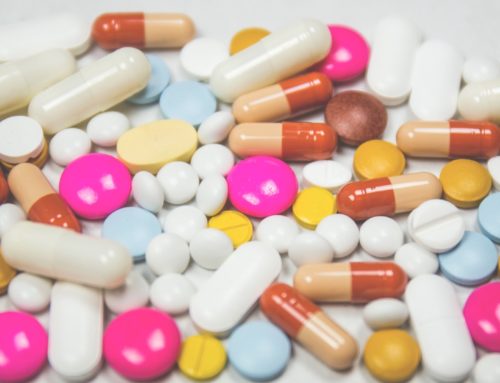Gout is the most common type of inflammatory arthritis, with the number of individuals who suffer from it increasing dramatically over the past two decades.
Approximately 8.3 Americans (equivalent to 4% of the population) experience the painful and recurrent acute attacks of arthritis ‘flare-ups’ that character this affliction, with additional medical issues such as obesity, hypertensive disorders, and cardiovascular disease often manifesting as co-morbidities (1).
What are the causes of gout?
The negative effects of gout are primarily caused by an underlying build up of monosodium urate crystallines within the joints that contribute to attacks that can last anywhere from a couple of days to a series of weeks (2).
The uric acid crystals themselves result from the natural breakdown of a substance called purines which exist within the genetic material of all living things — and therefore, foods.
While it’s impossible to avoid the consumption of foods containing purines for precisely this reason, there are particular foods that are better (and worse) than others. Diets featuring high quantities of animal proteins, sugar, high fructose corn syrup, alcoholic drinks, and sodas are significantly associated with an increase in uric acid production within the body, and, therefore, also an individual’s risk of gout (3).
It’s for this reason that Hippocrates once described gout as the “disease of kings,” as only the rich could afford to eat and drink themselves into sickness. 2,000 years on, however, and we are only just beginning to wake up to the true impact of diet on disease and disability.
What’s more, is that although even a single meal comprised of purine-rich meats can lead to a spike in uric acid levels that occurs almost instantly, diets that feature high levels of purine-rich plant foods, surprisingly seem to have the completely opposite effect (4).
Indeed, foods such as mushrooms, peas, cauliflower, lentils, and asparagus are all particularly high when it comes to their purine levels, albeit not quite as high as animal foods. Yet, the incorporation of these foods into an individual’s diet actually leads to further protection from the potential effects of gout.
An intervention trial found that by switching participants to a vegetarian diet, participants saw a 93% decline in the risk of uric acid crystallization… in only a matter of days. These findings, paired with countless others, indicate that contrary to what one might assume, the bodies of individuals eating a more alkaline diet — in this case, vegetarian, or plant-based — were significantly more efficient at flushing out excess uric acid from the bloodstream (5,6,7,8).
In other words, despite alkaline foods containing fewer purine bodies than their acidic, animal-based counterparts, they were actually better at enabling the body to prevent the build-up of any uric acid. Also important to note, is that these findings occurred whether the alkaline plant foods contained high levels of purines, or not (9).
The lack of association between purine-rich vegetables and gout is theorized to result from the protective properties that are naturally occurring within these foods, such as vitamin C, dietary fibre, and the presence of phytochemicals and disease-fighting anti-oxidants.
What does this have to do with tart cherries?
Speaking of anti-oxidants, an online survey conducted by the Gout and Uric Acid Education Society, found that 43% of respondents claimed to use cherry extract and/or tart cherry juice in the treatment and management of their gout (10). Okay… slightly bizarre, but go on.
Researchers were intrigued, and when it came to examining the effectiveness of these claims, they were shocked to find out that this peculiar home remedy seemed to be working in the vast majority of patients.
To date, the most comprehensive study conducted involved a total of 633 individuals who suffered from gout. The study found that tart cherry intake (approximately 10 per day) over a period of just two days, was associated with a 35% lower risk of gout attacks. This experiment was repeated using cherry extract in place of the whole fruit, and the same findings were, again, supported. These results occurred within all groups, even after they were categorized by obesity status, purine intake, use of anti-gout medication, as well as alcohol consumption (11).
According to the researchers, cherries — a fruit extremely rich in antioxidative bioactive compounds, to begin with — work to reduce uric acid within the body via a compound known as anthocyanins.
Anthocyanins are anti-inflammatory, which not only means that they help to ease the swelling and joint pain that accompanies a flare-up of gout, but also have the ability to significantly reduce the levels of uric acid within the bloodstream. Interestingly, the presence of anthocyanins in tart cherries is largely what’s responsible for their bright red colouring, with sweet cherries, on the other hand, tending to darken not long after harvesting (12).
Although other fruits are known to contain anthocyanins, (think blueberries, red cabbage, blackberries, and the skin of eggplant) there exists a stark lack of conclusive research (and likely the funding to support it) to establish any correlation between the consumption of these foods, and the prevention of gout.
Additionally, in an effort to determine a precise measurement for what the correct “dosage” of tart cherry juice might be, one study, in particular, failed to find any significant effect of the cherries, at all (13). The reason for this, researchers suggest, may lie in the high degree of variation between the methodologies and metrics used across the research on the topic (14).
Thus, it seems as though the question largely remains as to whether or not this sour fruit offers any benefits in the way of offering an effective alternative to gout medication, there is perhaps something to be said for eating a handful of tart cherries from time to time.
The cherry on top
Despite not yet being able to establish a precise dosage for cherry juice, nor whether or not it can actually solve all your gout-related problems, the Arthritis Foundation takes the “what is there to lose?” approach and recommends eating a handful of tart cherries — or, alternatively, an 8-oz serving of tart cherry juice — per day.
To answer their rhetorical question, there is absolutely nothing to lose — that is, unless you happen to be one of the unlucky 1.7% of Americans who suffer from an allergy to certain fruits.
Not only did *most* of the research note distinct improvements in gout-suffering participants that drank a glass of cherry juice per day, but the added nutrients that coincide with an increase in fruit consumption, are not to be overlooked.
The nutritional profile of an 8-oz glass of Montmorency tart cherry juice is as follows, with smaller quantities of calcium, iron, magnesium, omega-3 and omega-6 fats and B vitamins also present:
- Carbs: 28 grams
- Fiber: 5 grams
- Protein: 2 grams
- Fat: 1 gram
- Vitamin A: 62% of the RDI
- Vitamin C: 40% of the RDI
- Manganese: 14% of the RDI
- Potassium: 12% of the RDI
- Copper: 12% of the RDI
- Vitamin K: 7% of the RDI
Compared to their sweet counterparts, tart cherries contain roughly 20 times more vitamin A, with 500% higher antioxidant content to boot (15).
While it ought to be said that there’s no research to indicate that the amount of cherry juice you consume should depend on the intensity of your symptoms (i.e. don’t go overboard, and I’m sorry you’re suffering), the simple addition of a few fresh or frozen tart cherries to your daily meal plan, might just provide you with some of the sweet relief you’re looking for. “Tart” relief doesn’t quite have the same ring to it, but you get the point…
Alexandra Walker-Jones — February 2021
Text References:
- Roddy, E., Doherty, M. Gout. Epidemiology of gout. Arthritis Res Ther12, 223 (2010). https://doi.org/10.1186/ar3199
- Lamb KL, Lynn A, Russell J, et al. Effect of tart cherry juice on risk of gout attacks: protocol for a randomised controlled trial. BMJ Open 2020;10:e035108. doi: 10.1136/bmjopen-2019–035108
- K D Torralba, E De Jesus, S Rachabattula. The interplay between diet, urate transporters and the risk for gout and hyperuricemia: current and future directions. Int J Rheum Dis. 2012 Dec;15(6):499–506.
- J A Schmidt, F L Crowe, P N Appleby, T J Key, R C Travis. Serum uric acid concentrations in meat eaters, fish eaters, vegetarians and vegans: a cross-sectional analysis in the EPIC-Oxford cohort. PLoS One. 2013;8(2):e56339.
- H K Choi, K Atkinson, E W Karlson, W Willett, G Curhan. Purine-Rich Foods, Dairy and Protein Intake, and the Risk of Gout in Men. N Engl J Med. 2004 Mar 11;350(11):1093–103.
- R Villegas, R B Xiang, T Elasy, W H Xu, H Cai, Q Cai, M F linton, S Fazio, W Zheng, X O Shu. Purine-rich foods, protein intake, and the prevalence of hyperuricemia: the Shanghai Men’s Health Study. Nutr Metab Cardiovasc Dis. 2012 May;22(5):409–16.
- Y T Szeto, T C Kwok, I F Benzie. Effects of a long-term vegetarian diet on biomarkers of antioxidant status and cardiovascular disease risk. Nutrition. 2004 Oct;20(10):863–6.
- R Siener, A Hesse. The effect of a vegetarian and different omnivorous diets on urinary risk factors for uric acid stone formation. Eur J Nutr. 2003 Dec;42(6):332–7.
- Kanbara A, Miura Y, Hyogo H, Chayama K, Seyama I. Effect of urine pH changed by dietary intervention on uric acid clearance mechanism of pH-dependent excretion of urinary uric acid. Nutr J. 2012 Jun 7;11:39. doi: 10.1186/1475–2891–11–39. PMID: 22676161; PMCID: PMC3406944.
- Singh, J. A., Bharat, A., & Edwards, N. L. (2015). An internet survey of common treatments used by patients with gout including cherry extract and juice and other dietary supplements. Journal of clinical rheumatology : practical reports on rheumatic & musculoskeletal diseases, 21(4), 225–226. https://doi.org/10.1097/RHU.0000000000000246
- Zhang Y, Neogi T, Chen C, Chaisson C, Hunter DJ, Choi HK. Cherry consumption and decreased risk of recurrent gout attacks. Arthritis Rheum. 2012 Dec;64(12):4004–11. doi: 10.1002/art.34677. PMID: 23023818; PMCID: PMC3510330.
- Schlesinger N, Schlesinger M. Previously reported prior studies of cherry juice concentrate for gout flare prophylaxis: comment on the article by Zhang et al. Arthritis Rheum. 2013 Apr;65(4):1135–6. doi: 10.1002/art.37864. PMID: 23334899.
- Lisa K Stamp, Peter Chapman, Christopher Frampton, Stephen B Duffull, Jill Drake, Yuqing Zhang, Tuhina Neogi, Lack of effect of tart cherry concentrate dose on serum urate in people with gout, Rheumatology, Volume 59, Issue 9, September 2020, Pages 2374–2380,
- Pei-En Chen, Chia-Yu Liu, Wu-Hsiung Chien, Ching-Wen Chien, Tao-Hsin Tung,”Effectiveness of Cherries in Reducing Uric Acid and Gout: A Systematic Review”,Evidence-Based Complementary and Alternative Medicine, vol. 2019, Article ID 9896757, 7 pages, 2019. https://doi.org/10.1155/2019/9896757
- Kirakosyan, A., Seymour, E. M., Llanes, D. E. U., Kaufman, P. B., & Bolling, S. F. (2009). Chemical profile and antioxidant capacities of tart cherry products. Food Chemistry, 115(1), 20–25.





